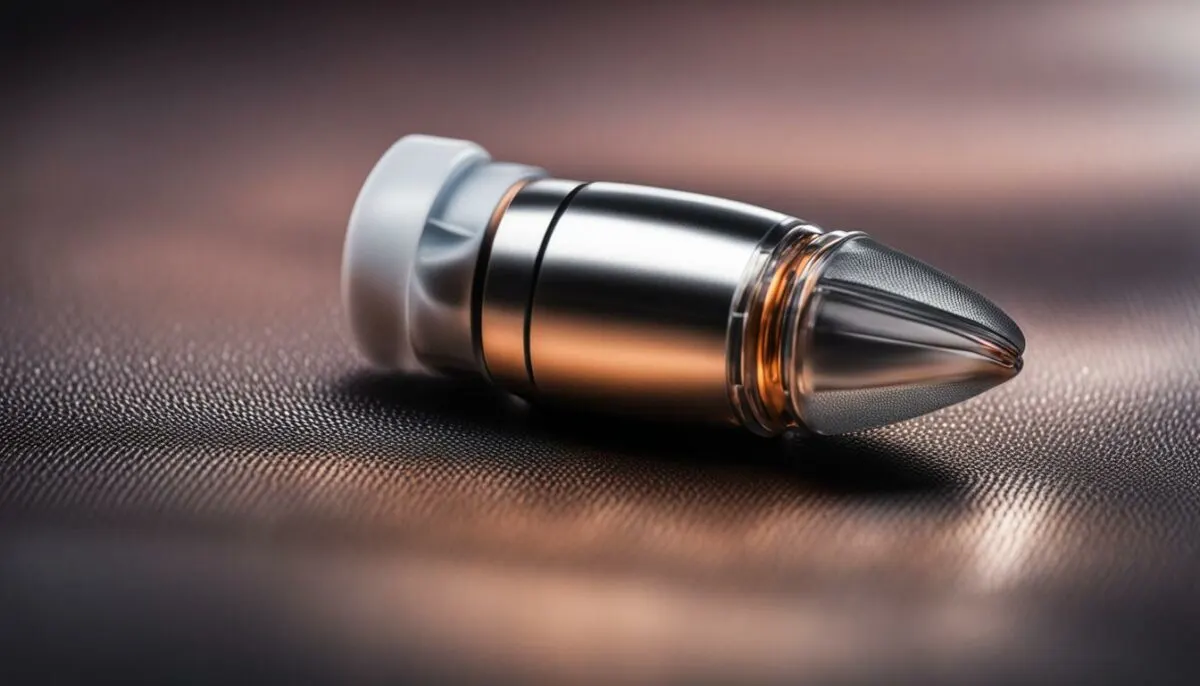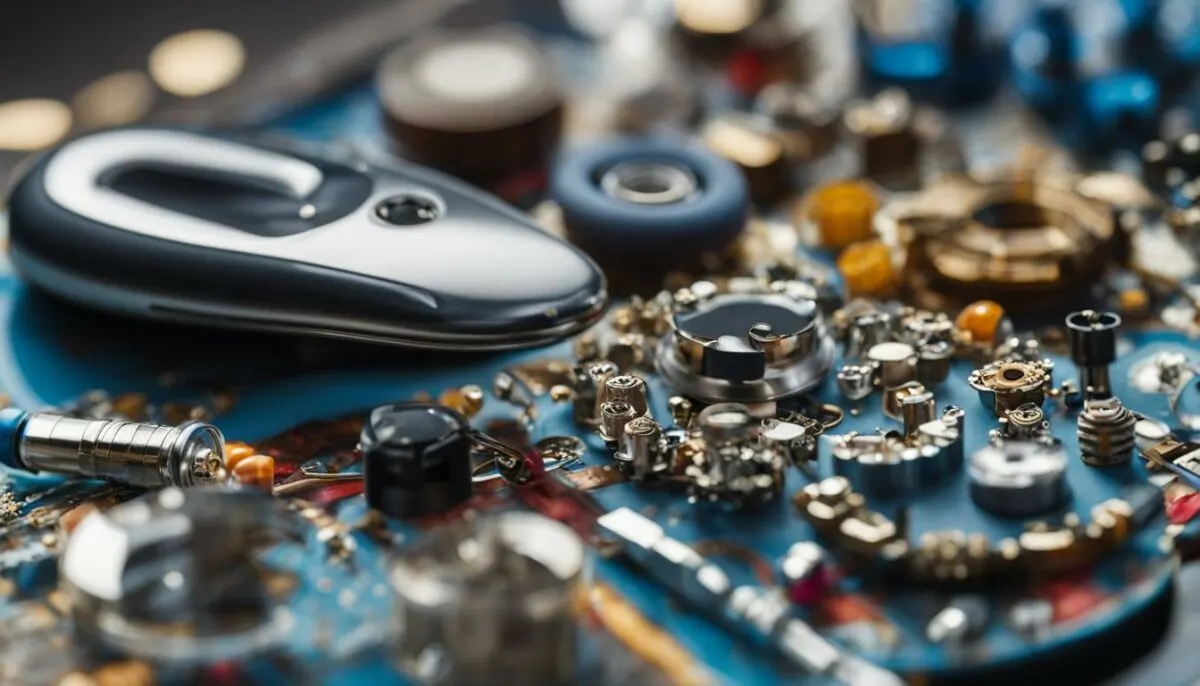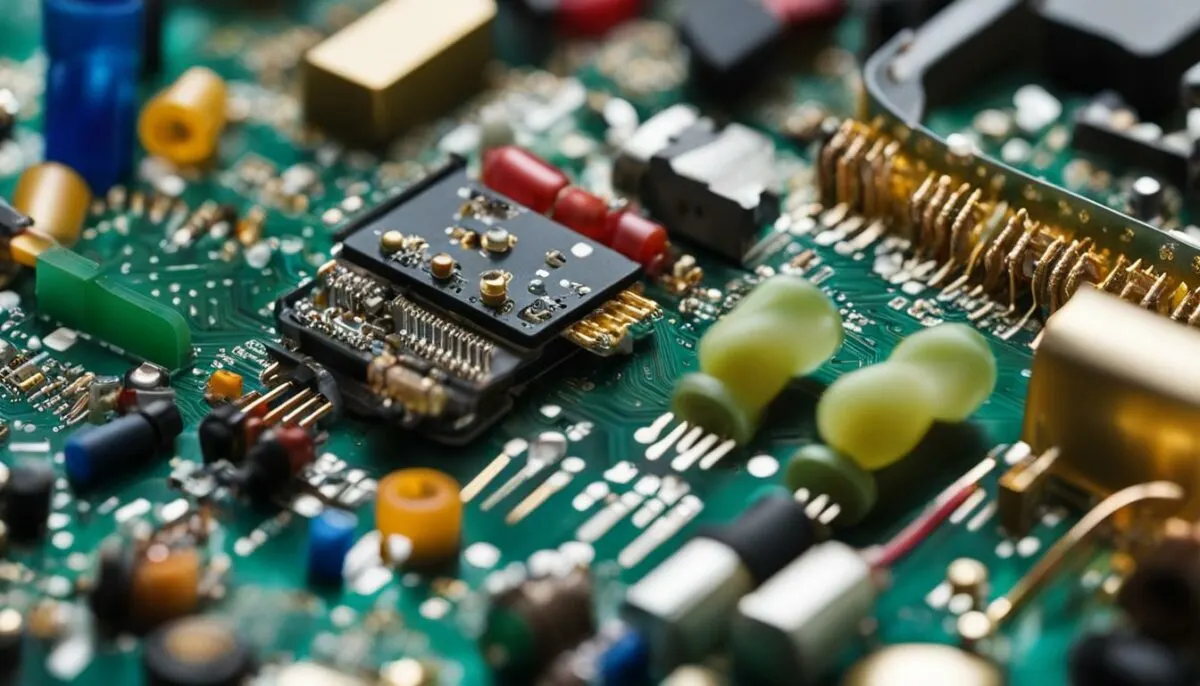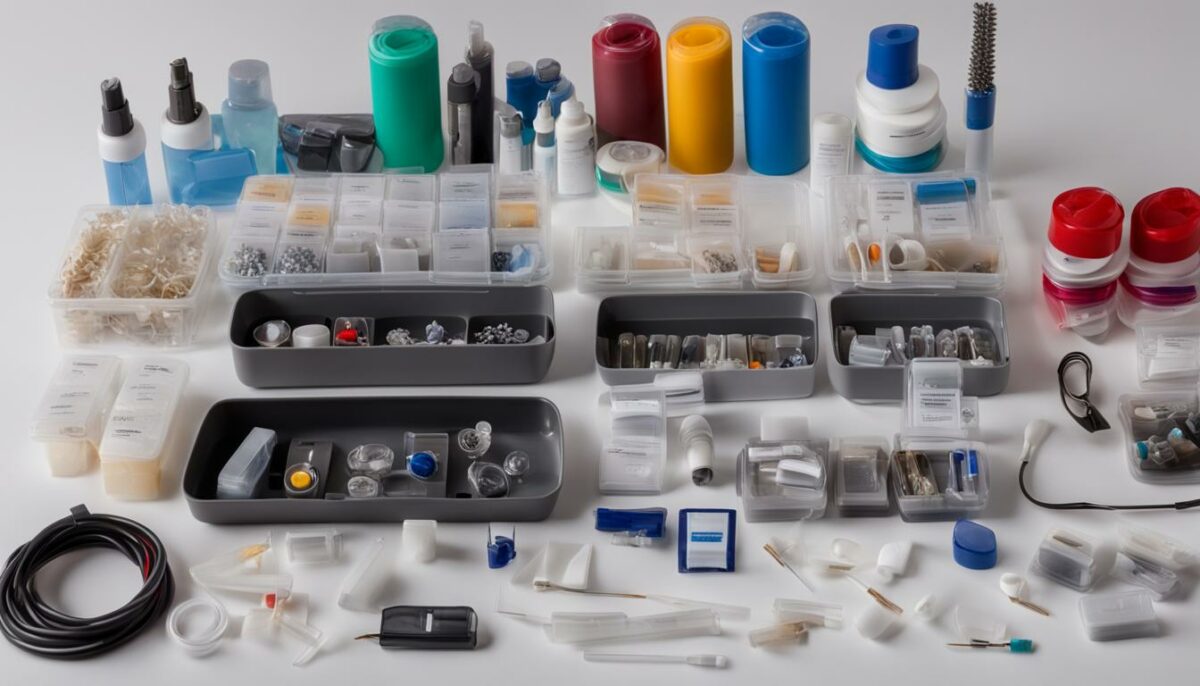Welcome to our comprehensive guide to hearing aid parts and accessories. If you or a loved one are new to the world of hearing aids, it can be overwhelming to understand the different components that make up these devices. In this section, we will explore everything you need to know about hearing aid parts and accessories, from the various components to the importance of maintenance and troubleshooting.
Key Takeaways
- Understanding the different components of a hearing aid is crucial for maximizing your hearing experience.
- Hearing aid parts and accessories range from batteries and tubes to cleaning tools and remote controls.
- Regular maintenance and cleaning can significantly impact the lifespan and performance of your hearing aid.
- It’s important to troubleshoot common hearing aid issues and consider upgrades or replacements when necessary.
- Reliable suppliers and personalized guidance from professionals can help ensure compatibility and quality for hearing aid parts and supplies.
Understanding Hearing Aid Components
When it comes to hearing aids, understanding the different components is key to making the right decisions about hearing aid supplies and spares. By knowing how each part functions and how they work together, you can make informed choices about your hearing aid and optimize your hearing experience.
Hearing Aid Microphones
The microphone is a crucial part of a hearing aid, as it captures and amplifies sound. There are two main types of microphone: directional and omnidirectional. Directional microphones are better at picking up sounds from a particular direction, and are useful in noisy environments. Omnidirectional microphones, on the other hand, pick up sounds from all directions, making them suitable for quiet or small group settings.
Hearing Aid Amplifiers
The amplifier is responsible for increasing the volume of sounds captured by the microphone. Modern hearing aids use digital amplifiers, which offer superior sound quality and greater flexibility than older analog models. Digital amplifiers can also be programmed to adjust to different listening environments, making them ideal for people with varying hearing requirements.
Hearing Aid Receivers
The receiver, also known as the speaker, is responsible for delivering sound to your ear. There are several types of receivers, including canal receivers, which fit snugly in the ear canal, and behind-the-ear receivers, which hook over the ear and rest behind the ear. When choosing a receiver, it’s important to consider your level of hearing loss and personal preferences for comfort.
Hearing Aid Batteries
Hearing aid batteries are essential for powering the hearing aid’s components. Most hearing aids use disposable batteries, which come in different sizes (typically labeled with color codes) depending on the hearing aid model. It’s important to replace your batteries regularly to ensure optimal performance. Consult your hearing healthcare professional for more information on the best batteries for your hearing aid.
Hearing Aid Supplies
Along with batteries, there are other essential supplies for maintaining and optimizing your hearing aid. These include cleaning tools, storage cases, and remote controls. Regular cleaning is important to prevent earwax buildup and ensure optimal sound delivery. A storage case protects your hearing aid when not in use, and remote controls can provide ease of use and greater functionality.
In conclusion, understanding the various components of a hearing aid is essential to making informed decisions about hearing aid supplies and spares. Consider your needs and preferences when choosing microphones, amplifiers, receivers, and batteries. Don’t forget to stock up on supplies, such as cleaning tools and storage cases, to keep your hearing aid in top condition.
Exploring Hearing Aid Batteries and Battery Life

Hearing aid batteries are an essential component of your hearing aid. They provide the power needed for your device to function and allow you to hear the world around you. Understanding the different types of batteries and how to maintain them is crucial in ensuring maximum performance and battery life.
Most hearing aids use disposable batteries that come in standard sizes (such as size 312, 13, or 10). These batteries typically last anywhere from three days to two weeks, depending on factors such as the size of the battery and the amount of power needed for your specific hearing aid.
It is important to note that the lifespan of your hearing aid battery can be affected by a variety of factors, such as temperature, humidity, and usage. To get the most out of your batteries, keep them in a cool, dry place and avoid exposure to extreme temperatures or moisture.
To ensure maximum battery performance, it is important to follow proper usage and storage guidelines. Always remove the tab from the battery before inserting it into your hearing aid, and wait a few minutes before closing the battery compartment to allow the battery to activate fully. When storing your hearing aid, turn it off and remove the battery to prevent energy drainage.
If you find that your batteries are not lasting as long as they should, consider consulting with your hearing care professional. They may be able to recommend alternative batteries or help identify underlying issues that could be affecting battery performance.
Remember, proper battery maintenance is key to improving your hearing aid experience. With the right care and attention, you can ensure that your hearing aid battery is always ready to provide the power you need to hear the world around you.
Understanding Hearing Aid Tubes and Domes

If you wear hearing aids, you know that these small yet complex devices rely on a variety of components to improve your hearing. One such component that plays a crucial role in your hearing aid’s performance is the hearing aid tube and dome.
Hearing aid tubes are small, flexible tubes that connect the device’s receiver to the earmold or dome. They help to deliver sound from the hearing aid to your ear canal. Alternatively, hearing aid domes are small silicone or rubber pieces that fit inside your ear canal. They help to keep your hearing aid comfortably in place while also providing a seal that reduces feedback and enhances sound quality.
The Importance of Hearing Aid Tubes and Domes
Choosing the right tubes and domes for your hearing aid is crucial to optimizing your hearing experience. Properly fitting tubes and domes can help ensure that the sound reaches your ear canal effectively, improving the clarity of the sound and reducing feedback.
There are several factors to consider when choosing tubes and domes for your hearing aid:
- The size and shape of your ear canal
- Your level of hearing loss
- The type of hearing aid you use
- Your comfort level with the fit
Note that tubes and domes often need to be replaced regularly to maintain optimal performance. Consult with your hearing care professional to determine the appropriate replacement schedule for your specific hearing aid model.
How to Maintain and Replace Hearing Aid Tubes and Domes
Regular cleaning and maintenance are essential for prolonging the life of your hearing aid tubes and domes. Proper care can help prevent clogs or damage that can impact the sound quality and reduce the lifespan of these components.
Here are some tips to help maintain your hearing aid tubes and domes:
- Wipe them down regularly with a clean, dry cloth to remove any wax or debris
- Replace them as needed according to the manufacturer’s guidelines
- Take care when inserting them to avoid damage
- Store them in a cool, dry place to prevent damage from moisture or heat
If you experience any issues with your hearing aid tubes or domes, it’s important to consult with your hearing care professional. They can help diagnose the issue and recommend appropriate repairs or replacements.
Common Hearing Aid Accessories

There are a variety of hearing aid accessories available to help make your daily experience with hearing aids more convenient and effective. Here are some of the most common accessories:
| Accessory | Description |
|---|---|
| Cleaning tools | These tools help keep your hearing aids clean and free of debris, preventing damage and improving sound quality. |
| Storage cases | These cases protect your hearing aids when they are not in use, preventing damage and making them easy to find and access. |
| Remote controls | These devices allow you to adjust the settings on your hearing aids, such as volume and program selection, without having to remove them. |
| Earplugs/earmolds | These accessories help to improve the fit and comfort of your hearing aids, ensuring that they stay in place and provide optimal sound quality. |
In addition to these common accessories, there are also specialized accessories available for specific situations, such as hearing aid sweatbands for active individuals or hearing aid dehumidifiers for those who live in humid climates.
When selecting hearing aid accessories, it is important to ensure that they are compatible with your specific hearing aids. Your hearing healthcare professional can provide guidance on which accessories are best suited for your needs.
Importance of Hearing Aid Maintenance and Cleaning

Regular maintenance and cleaning of your hearing aid is crucial for optimal functionality and longevity. The following tips can help ensure your hearing aid accessories, replacements, and repair parts are in top condition:
1. Clean your hearing aid daily
Use a soft, dry cloth to wipe the surface of your hearing aid and remove any debris or earwax. Avoid using water, alcohol, or cleaning solutions, as they can damage the delicate components of your device.
2. Use hearing aid accessories
Hearing aid accessories such as cleaning tools and storage cases can help maintain the condition of your device. Cleaning tools, such as wax removal brushes, can help remove stubborn earwax, while storage cases can protect your device from damage and prolong its lifespan.
3. Know when to replace accessories and parts
Regularly inspect your hearing aid accessories and parts, such as tubes and domes, for signs of wear and tear. If you notice any damage, cracks, or discoloration, it may be time to replace them. Consult with a professional for guidance on compatible replacements and repair parts.
4. Avoid exposing your device to extreme conditions
Keep your hearing aid away from high temperatures, moisture, and direct sunlight. These conditions can damage the components of your device and affect its performance.
| Hearing aid accessories | Importance |
|---|---|
| Cleaning tools | Help remove earwax and debris, prolonging device lifespan |
| Storage cases | Protect device from damage and provide convenience |
| Remote controls | Enable easy adjustments of device settings and volume |
By following these tips for maintenance and cleaning, you can maximize the lifespan and performance of your hearing aid accessories, replacements, and repair parts. Don’t hesitate to contact a professional for personalized guidance and support on maintaining and optimizing your device’s functionality.
Tips for Troubleshooting Hearing Aid Issues

While hearing aids are an essential tool for improving hearing, they can sometimes encounter issues that need troubleshooting. Here are some tips to help you troubleshoot your hearing aid’s problems easily and quickly.
Check the Batteries
The most common reason for a hearing aid not working correctly is dead batteries. Check your batteries to ensure they are properly inserted and have charge. If your hearing aid is still not working, try replacing the batteries with new ones. Properly disposing of old batteries is essential, so be sure to follow this guide.
Clean the Hearing Aid
Accumulation of dirt and wax can cause blockages in your hearing aid, leading to a decrease in sound quality. Gently clean your hearing aid with a soft-bristled brush. Remove any wax by using a wax removal tool. Avoid using water, as moisture can damage your hearing aid.
If the problem persists, it might be time for a professional cleaning service, particularly if your hearing aid is a custom model.
Inspect the Tubing
The tubing and the dome on your hearing aid can be the cause of sound obstruction. Check the tubing and dome for signs of blockage or damage. If the tubing is damaged, it may need to be replaced.
| Signs of damaged tubing | Solution |
|---|---|
| Cracks or splits | Replace the tubing |
| Discoloration | Consult a professional |
Replace the Wax Filter
Wax filters protect the hearing aid from earwax and debris. You must replace your wax filter frequently, depending on your hearing aid’s model and usage. Check your hearing aid’s manual for instructions on how to replace it.
Seek Professional Assistance
If the above steps do not resolve the problem, it’s time to seek professional assistance. A hearing aid specialist can diagnose the issue and perform repairs or replace the hearing aid parts if needed.
Proper maintenance and care of your hearing aid can prevent many problems. However, if you face any issues, follow these tips to troubleshoot your hearing aid.
Exploring Upgrades and Replacements

While hearing aids can last for several years, it may be necessary to consider upgrading or replacing certain parts to ensure optimal performance. This is particularly true for electronics, which can become outdated as newer technologies and advancements enter the market. Some common reasons for upgrading or replacing hearing aid parts include:
- Damage or wear and tear
- Lifestyle changes and evolving hearing needs
- Difficulty finding replacement parts
- Desire for newer features and technologies
It is important to consult with a hearing healthcare professional to determine which upgrades or replacements may be necessary or beneficial for your specific situation. They can provide personalized guidance and recommendations based on a thorough evaluation of your hearing aids and hearing needs.
If upgrading or replacing hearing aid parts, it is essential to use high-quality and compatible replacements. Using subpar or incompatible parts can result in poor performance and even damage to your hearing aids. Reputable suppliers, such as those recommended by your hearing healthcare professional, can provide reliable hearing aid replacements and repair parts.
Tips for Finding Compatible Upgrades and Replacements
When searching for compatible upgrades and replacements for your hearing aids, consider the following:
- Consult with your hearing healthcare professional for recommendations and guidance.
- Research and compare different suppliers to ensure quality and compatibility.
- Review product specifications and compatibility information before purchasing.
- Avoid using unauthorized or counterfeit parts.
- Consider warranties and return policies when making purchases.
By following these tips and working with a trusted hearing healthcare professional, you can ensure optimal performance and longevity for your hearing aids. Don’t hesitate to seek professional help or advice if you have any questions or concerns about upgrading or replacing your hearing aid parts.
Finding Reliable Hearing Aid Parts and Supplies

When it comes to finding reliable and high-quality hearing aid parts and supplies, there are a few key considerations to keep in mind.
Consider the Manufacturer
One important factor to consider is the manufacturer of your hearing aid. It is generally recommended to purchase parts and supplies that are made by the same manufacturer as your hearing aid. This helps ensure compatibility and can help prevent potential issues with performance or fit.
Research Suppliers
Another tip for finding reliable hearing aid supplies is to research suppliers. Look for companies that specialize in hearing aid products and have a strong reputation in the industry. Additionally, read reviews and speak to other hearing aid users to get recommendations for reliable suppliers.
Check for Compatibility
Before making any purchases, be sure to check for compatibility with your specific hearing aid model. This can help prevent any issues with fit or performance. If you are unsure about whether a certain part or supply is compatible, reach out to the manufacturer or supplier for guidance.
Take Advantage of Professional Guidance
Finally, don’t be afraid to seek professional guidance when it comes to finding the right parts and supplies for your hearing aid. Your hearing healthcare provider or audiologist can offer personalized recommendations and guidance based on your specific needs and hearing aid model.
By taking the time to research and select reliable hearing aid parts and supplies, you can help ensure optimal performance and extend the life of your hearing aid.
“Investing in high-quality hearing aid parts and supplies can make a significant difference in the performance and longevity of your hearing aid.”
Conclusion
As you’ve learned in this comprehensive guide, understanding the various components of your hearing aid is crucial to optimizing your hearing experience. By delving into the world of hearing aid parts and accessories, you can gain insights into the purpose and functionality of each component. From microphones and amplifiers to batteries and tubes, every part of your hearing aid plays a role in delivering clear and comfortable sound.
Regular maintenance and cleaning are also important factors to consider. By properly caring for your hearing aid and utilizing accessories such as cleaning tools and storage cases, you can prolong its lifespan and ensure optimal performance.
Consult Professionals for Personalized Guidance
Remember, while this guide provides a comprehensive understanding of hearing aid parts and accessories, it’s always a good idea to seek personalized guidance and support from a professional. They can help you determine the best parts and supplies for your specific needs and offer repair and replacement services if necessary.
When sourcing hearing aid parts and supplies, be sure to consult with reputable suppliers and consider compatibility and quality. Upgrading or replacing certain parts can also be beneficial, as newer technologies and advancements in the field can further enhance your hearing experience.
Thank you for reading this comprehensive guide on hearing aid parts and accessories. Armed with this knowledge, you can now take the necessary steps to optimize your hearing and enhance your overall quality of life.
FAQ
What are the main components of a hearing aid?
The main components of a hearing aid include microphones, amplifiers, receivers, and batteries.
How do hearing aid batteries impact battery life?
Hearing aid batteries play a crucial role in determining battery life. Higher quality batteries tend to last longer, and proper usage and storage can also extend battery life.
What are hearing aid tubes and domes?
Hearing aid tubes and domes are essential components that deliver sound from the hearing aid to the ear. Tubes connect the hearing aid to the earpiece, while domes provide a comfortable fit.
What are some common hearing aid accessories?
Common hearing aid accessories include cleaning tools, storage cases, and remote controls. These accessories can improve convenience and functionality.
How important is regular maintenance and cleaning for hearing aids?
Regular maintenance and cleaning are essential for preserving the performance of hearing aids. Proper cleaning techniques and the use of accessories can prevent damage and prolong the lifespan of the device.
What are some tips for troubleshooting hearing aid issues?
Basic troubleshooting techniques include checking for battery issues, cleaning the device, and ensuring proper placement in the ear. If issues persist, it may be necessary to seek professional help.
When should I consider upgrading or replacing hearing aid parts?
Upgrading or replacing certain hearing aid parts may be necessary if they no longer provide sufficient amplification or if technologies have significantly advanced. Consulting with a professional can help determine the right course of action.
Where can I find reliable hearing aid parts and supplies?
Reliable hearing aid parts and supplies can be sourced from reputable suppliers. It’s important to consider compatibility and quality when purchasing batteries, tubes, and domes.